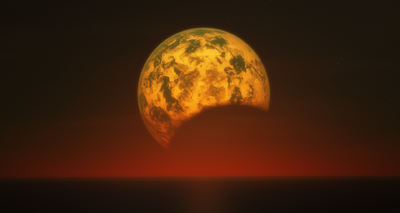Haki: Difference between revisions
Unuvun Rain (talk | contribs) (Created page with "'''Haki''' is the smaller of the two planets in the Pavala-Haki system, the larger being Pavala") |
No edit summary |
||
| (5 intermediate revisions by 2 users not shown) | |||
| Line 1: | Line 1: | ||
'''Haki''' is the smaller of the two planets in the Pavala-Haki system, the larger being [[Pavala]] | [[File:Haki.png|thumb|right|400px|Haki as viewed from the surface of Pavala, during an eclipse.]] | ||
'''Haki''' is the smaller of the two planets in the Pavala-Haki system, the larger being [[Pavala]]. It is by far the brightest object in the night sky, making nighttime on the Haki-facing side of Pavala bright enough that one can read. | |||
In recent decades, Pavalans have begun colonizing Haki, with an exponentially rising number of people living on Haki. | |||
== Astronomy == | |||
The dimmest objects visible to the naked eye on the Haki-facing side are around magnitude +2. The influence of Haki on the nighttime sky extends somewhat beyond the terminator, as in the region immediately beyond Haki's visibility, there is a red glow all night long on the horizon facing Haki from atmospheric scattering. This fades away beyond the region where Haki is around ten degrees below the horizon. | |||
Eclipses of Haki by Pavala are very frequent, happening in two seasons per year. These seasons last for about ten to fifteen Pavalan days each (i havent checked precisely how long they are), meaning that for ~15% of days per year, Haki is visibly eclipsed at night. Haki also frequently eclipses Pavala, with total eclipses lasting slightly less time on Pavala than they do on Haki. | |||
Pavala and Haki are at the perfect distance from each other to allow for very rare total eclipses of Haki as viewed from Pavala. During these eclipses, the minimum magnitude of visible object rises to +6 to +7 as on Earth during moonless nights. These total eclipses only occur a few times per decade and last for only a few minutes each. In pre-scientific times, these moments were seen as very special and feature frequently in mythologies across Pavala. | |||
Latest revision as of 12:39, 11 October 2024

Haki is the smaller of the two planets in the Pavala-Haki system, the larger being Pavala. It is by far the brightest object in the night sky, making nighttime on the Haki-facing side of Pavala bright enough that one can read.
In recent decades, Pavalans have begun colonizing Haki, with an exponentially rising number of people living on Haki.
Astronomy
The dimmest objects visible to the naked eye on the Haki-facing side are around magnitude +2. The influence of Haki on the nighttime sky extends somewhat beyond the terminator, as in the region immediately beyond Haki's visibility, there is a red glow all night long on the horizon facing Haki from atmospheric scattering. This fades away beyond the region where Haki is around ten degrees below the horizon.
Eclipses of Haki by Pavala are very frequent, happening in two seasons per year. These seasons last for about ten to fifteen Pavalan days each (i havent checked precisely how long they are), meaning that for ~15% of days per year, Haki is visibly eclipsed at night. Haki also frequently eclipses Pavala, with total eclipses lasting slightly less time on Pavala than they do on Haki.
Pavala and Haki are at the perfect distance from each other to allow for very rare total eclipses of Haki as viewed from Pavala. During these eclipses, the minimum magnitude of visible object rises to +6 to +7 as on Earth during moonless nights. These total eclipses only occur a few times per decade and last for only a few minutes each. In pre-scientific times, these moments were seen as very special and feature frequently in mythologies across Pavala.